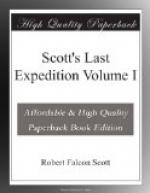Had an interesting talk with Taylor on agglomerate and basaltic dykes of Castle Rock. The perfection of the small cone craters below Castle Rock seem to support the theory we have come to, that there have been volcanic disturbances since the recession of the greater ice sheet.
It is a great thing having Wright to fog out the ice problems, and he has had a good opportunity of observing many interesting things here. He is keeping notes of ice changes and a keen eye on ice phenomena; we have many discussions.
Yesterday Wilson prepared a fry of seal meat with penguin blubber. It had a flavour like cod-liver oil and was not much appreciated—some ate their share, and I think all would have done so if we had had sledging appetites—shades of Discovery days!!_16_
This Emperor weighed anything from 88 to 96 lbs., and therefore approximated to or exceeded the record.
The dogs are doing pretty well with one or two exceptions. Deek is the worst, but I begin to think all will pull through.
Thursday, April 6, A.M.—The weather continued fine and clear yesterday—one of the very few fine days we have had since our arrival at the hut.
The sun shone continuously from early morning till it set behind the northern hills about 5 P.M. The sea froze completely, but with only a thin sheet to the north. A fairly strong northerly wind sprang up, causing this thin ice to override and to leave several open leads near the land. In the forenoon I went to the edge of the new ice with Wright. It looked at the limit of safety and we did not venture far. The over-riding is interesting: the edge of one sheet splits as it rises and slides over the other sheet in long tongues which creep onward impressively. Whilst motion lasts there is continuous music, a medley of high pitched but tuneful notes—one might imagine small birds chirping in a wood. The ice sings, we say.
P.M.—In the afternoon went nearly two miles to the north over the young ice; found it about 3 1/2 inches thick. At supper arranged programme for shift to Cape Evans—men to go on Saturday—dogs Sunday—ponies Monday—all subject to maintenance of good weather of course.
Friday, April 7.—Went north over ice with Atkinson, Bowers, Taylor, Cherry-Garrard; found the thickness nearly 5 inches everywhere except in open water leads, which remain open in many places. As we got away from the land we got on an interesting surface of small pancakes, much capped and pressed up, a sort of mosaic. This is the ice which was built up from lee side of the Strait, spreading across to windward against the strong winds of Monday and Tuesday.
Another point of interest was the manner in which the overriding ice sheets had scraped the under floes.
Taylor fell in when rather foolishly trying to cross a thinly covered lead—he had a very scared face for a moment or two whilst we hurried to the rescue, but hauled himself out with his ice axe without our help and walked back with Cherry.




